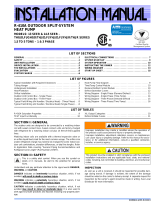
5
Use a separate branch electrical circuit for this
unit. See the unit wiring label for proper high
and low voltage wiring.
208/240 volt units are shipped from the factory
wired for 240 volt transformer operation. For
208 volt operation, remove the lead from the
transformer terminal marked 240v and connect
it to the terminal marked 208v.
Provide power supply for the unit in accordance
with the unit wiring diagram and the unit rating
plate. Use copper wire only for the line voltage
power supply to this unit.
Check all factory wiring per the unit wiring
diagram and inspect the factory wiring connec-
tions to be sure none were loosened in transit
or installation.
Some units are equipped with a liquid line
solenoid valve. Connect the loose yellow wire
to the Y1 thermostat wire as shown in the wir-
ing diagram.
Refer to Figure 2 for typical low voltage system
wiring.
CAUTION:
Make sure all doors are installed be-
fore restoring power to the unit.
5. START-UP AND ADJUSTMENT
Selecting Proper Blower Speed for Multi-
Speed Units — The blower speed is preset
at the factory for operation at the same speed
for heating and cooling. For optimum system
performance and comfort, it may be necessary
to change the factory set speed. To change the
blower speed, disconnect all electrical power to
the unit and remove the upper door. Remove
the black wire from the blower motor terminal.
Connect the black wire to the desired blower
speed marked on the terminal block of the blower
motor. Terminal 5 = Hi speed, terminal 4 = Med
Hi speed, terminal 3 = Med speed, terminal 2 =
Med Low speed, terminal 1 = Low speed. See
Table 1 for airfl ow data.
Replace the upper door and secure it to the
unit. Restore power to the unit.
Selecting Blower Speed for Fan Only Opera-
tion — Units are equipped with the capability of
selectable fan only blower speeds. To change
the factory set blower speed, disconnect all
electrical power to the unit and remove the upper
door. Remove the green wire from the blower
motor terminal. Connect the green wire to the
desired blower speed marked on the terminal
block of the blower motor. Terminal 5 = Hi speed,
terminal 4 = Med Hi speed, terminal 3 = Med
speed, terminal 2 = Med low speed, terminal
1 = Low speed.
Replace the upper door and secure it to the
unit. Restore power to the unit.
6. CARE AND MAINTENANCE
General — For continued high performance,
and to minimize the risk of equipment failure, it
is essential that periodic maintenance be per-
formed on this equipment. The ability to properly
perform maintenance on this equipment requires
certain mechanical skills and tools. If you do not
possess these skills, contact your dealer for
maintenance. Consult your local dealer as to
the availability of a maintenance contract.
Do not store any of the following on, or in contact
with, the unit: Rags, brooms, vacuum cleaners,
or other cleaning tools, spray or aerosol cans,
soap powders, bleaches, waxes, cleaning
compounds, plastics or plastic containers,
paper bags or other paper products, gasoline,
kerosene, cigarette lighter fl uid, dry cleaning
fl uids, paint thinners, or other volatile fl uids.
Proper maintenance is most important to achieve
the best performance from an air handler. At a
minimum, this maintenance should include the
following items.
1. Inspect and clean or replace the air fi lter at
the beginning of each heating and cooling
season, or more frequently as required.
2. Inspect the cooling coil, drain pan, and
condensate drain at the beginning of each
cooling season for cleanliness. Clean these
components as necessary using a mild
detergent and water. Flush the coil, drain
pan, and condensate drain after cleaning
to remove all detergent. Use caution when
cleaning these components so that the
insulation does not become wet.
3. Inspect the blower motor and wheel for
cleanliness at the beginning of each heat-
ing and cooling season. Clean the motor
as necessary.
4. Inspect electrical connections for tightness
at the beginning of each heating and cooling
season. Service as necessary.








